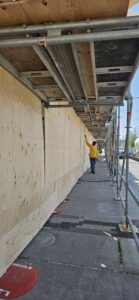Introduction
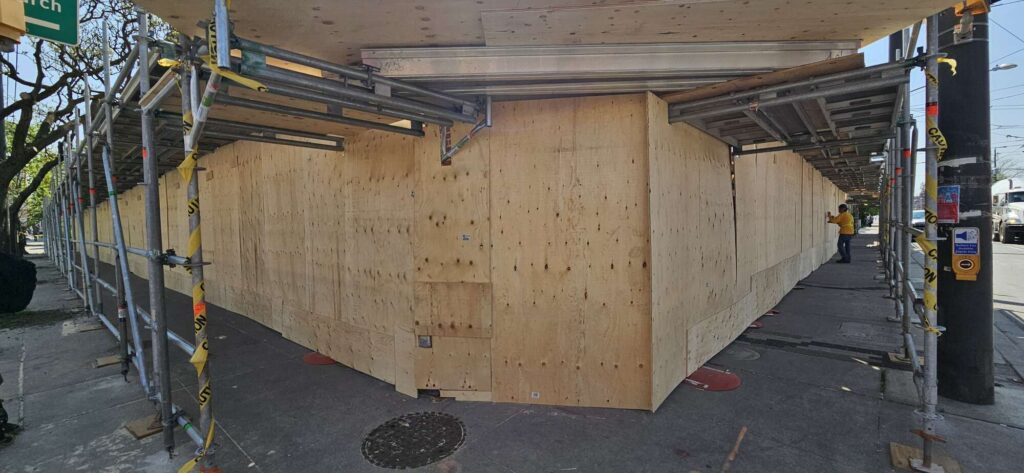
In Toronto, construction is always happening. As buildings go up and get fixed up, sidewalks need to stay safe for both the construction workers and the people walking by. That’s where sidewalk scaffolding comes in. This is sometimes also referred to as a sidewalk canopy or sidewalk shed.
Sidewalk scaffolding is a temporary structure built over sidewalks during construction or renovation projects. It serves as a protective barrier, shielding pedestrians from falling debris, tools, and other hazards. Not only does it create a safer environment for everyone, but it also helps maintain access to businesses and public spaces.
At PEAK Scaffolding, we’re experts in sidewalk scaffolding. We know how to make sure it’s safe and follows all the rules and regulations. So, let’s dive in and learn all about how sidewalk scaffolding keeps Toronto’s sidewalks safe and easy to use!
Why Sidewalk Scaffolding is Essential in Toronto
Sidewalk scaffolding plays a crucial role in keeping Toronto’s sidewalks safe and accessible during construction. Here’s why it’s so important:
Safety for Pedestrians: Imagine walking down a busy street with construction happening overhead. Without sidewalk scaffolding, you’d be at risk of being hit by falling objects like tools, bricks, or debris. Sidewalk scaffolding acts as a protective shield, keeping pedestrians safe from harm.
Accessibility: Toronto is a diverse city, and it’s important to ensure that everyone can use the sidewalks, even during construction. Sidewalk scaffolding maintains a clear pathway for pedestrians, including people with disabilities, parents with strollers, and anyone else who needs to use the sidewalk.
Protection for Property: Sidewalk scaffolding doesn’t just protect people; it also protects the building being worked on and the surrounding structures. It prevents accidental damage from falling materials or tools, keeping the neighbourhood looking its best.
Efficiency for Workers: Construction crews need a safe and stable platform to work from when they’re high up. Sidewalk scaffolding provides that platform, allowing them to focus on their tasks without worrying about falling or dropping tools. This makes the work go faster and smoother.
Legal Requirement: In Toronto, it’s not just a good idea to have sidewalk scaffolding – it’s the law. The city has strict rules about when and how it needs to be used. This helps make sure that every construction site is safe for everyone involved.
Sidewalk scaffolding is much more than just a construction tool. It’s a vital part of making sure that Toronto’s busy streets stay safe and open for everyone. It’s a win-win situation for both the construction crews and the people who live, work, and visit the city.
Toronto Regulations for Sidewalk Scaffolding: A Deep Dive
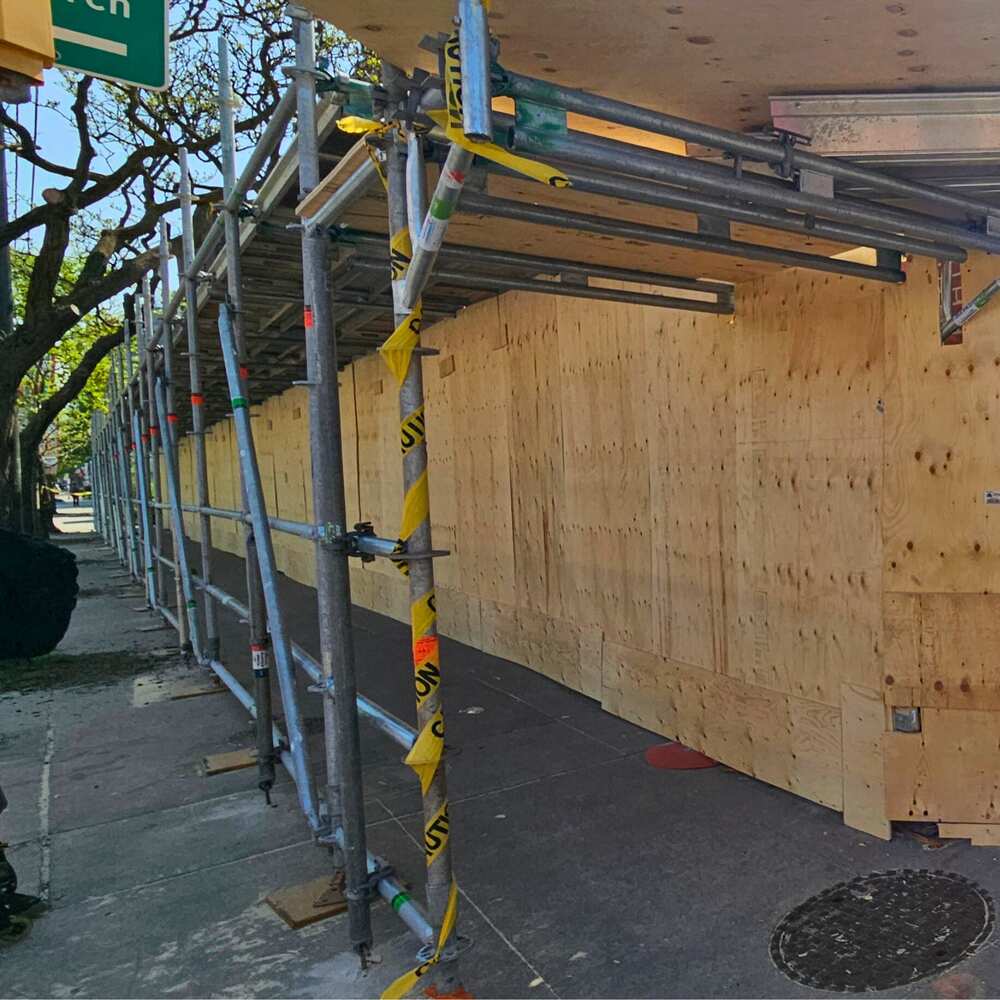
Keeping sidewalks safe during construction is a top priority in Toronto. That’s why there are strict rules about how sidewalk scaffolding is built and used. Understanding these rules is important for anyone involved in construction projects in the city.
Toronto Municipal Code Chapter 447: The Rulebook
The most important set of rules for sidewalk scaffolding in Toronto is found in the Toronto Municipal Code Chapter 447. This chapter lays out everything you need to know, including:
- Permits: You need a permit before you can put up sidewalk scaffolding. The permit application needs to include detailed drawings and plans of the scaffolding, proof of insurance, and other documents.
- Design: There are rules about how big the scaffolding can be, how much space it needs to leave for people to walk by, and how it needs to be lit up at night. It also has to have signs warning people about the construction.
- Accessibility: The scaffolding can’t block the sidewalk completely. It has to have enough space for people with wheelchairs or strollers to get by easily. Usually, this means having a ramp or a wide enough walkway.
Other Rules You Need to Know
Besides the municipal code, there are a few other rules you need to keep in mind:
- Ontario’s Rules: Toronto’s rules work together with the provincial rules for safety at work (like the Occupational Health and Safety Act). These rules cover things like making sure workers are safe on the scaffolding.
- Building Code: The Toronto Building Code might also have some extra rules about sidewalk scaffolding, especially for certain kinds of buildings or special situations.
PEAK Scaffolding's Expertise with the Rules
Figuring out all these rules can be a bit tricky. That’s where PEAK Scaffolding comes in. We know all the ins and outs of Toronto’s scaffolding rules. We can help you understand what you need to do and make sure your project follows all the guidelines.
By understanding and following these regulations, you’re not just protecting pedestrians and workers; you’re also ensuring your project runs smoothly and avoids any costly delays or fines due to non-compliance.
Design and Construction of Sidewalk Scaffolding: Building for Safety and Access
Sidewalk scaffolding is a temporary structure, but that doesn’t mean it’s thrown together haphazardly. It needs to be carefully designed and built to keep people safe and the sidewalk accessible. Let’s look at what goes into making sure sidewalk scaffolding is both strong and user-friendly.
Key Design Considerations
When designing sidewalk scaffolding, we need to think about a few important things:
- Strength and Stability: The scaffolding has to be strong enough to hold the weight of workers, tools, materials, and even things like snow or strong winds. It’s like building a temporary bridge over the sidewalk, so it needs to be sturdy.
- Enough Space for People: People need to be able to walk comfortably under the scaffolding. There needs to be enough headroom and space for wheelchairs and strollers to pass through easily.
- Keeping Things Safe: We need to make sure nothing falls from the scaffolding onto the sidewalk. This usually means adding a roof or netting to catch anything that might drop.
- Easy to Use for Everyone: We can’t forget about people with disabilities. The scaffolding needs to have ramps or other ways for them to get around it easily.
Materials and Components
Sidewalk scaffolding is usually made of steel or aluminum. These materials are strong, last a long time, and can handle Toronto’s weather. Some of the main parts of the scaffolding are:
- Standards: These are the vertical poles that hold everything up.
- Ledgers: These are the horizontal bars that connect the standards, creating the frame.
- Braces: These are diagonal bars that make the scaffolding even stronger and more stable.
- Decking: This is the platform or walkway that people walk on or workers stand on.
It’s super important to use good quality materials and make sure all the parts fit together properly. This helps keep the scaffolding safe and strong for as long as it’s needed.
The Sidewalk Scaffolding Permit Process in Toronto: Getting the Green Light
Before you can erect sidewalk scaffolding in Toronto, you need to get permission from the city. This involves applying for and obtaining a sidewalk scaffolding permit. Let’s break down the process and what you need to know.
Application Requirements: What You Need to Submit
To apply for a sidewalk scaffolding permit in Toronto, you’ll typically need to provide the following:
- Detailed Drawings and Plans: This includes scaled drawings showing the scaffolding’s dimensions, location on the sidewalk, and any proposed encroachments into the street or other public spaces.
- Proof of Insurance: You’ll need to show that you have adequate liability insurance to cover any potential accidents or damages related to the scaffolding.
- Other Documentation: Depending on your project, additional documents may be required, such as a traffic management plan or a letter of authorization from the property owner.
It’s important to ensure that all your documentation is accurate, complete, and meets the city’s requirements. Any errors or omissions can delay the approval process.
Approval Timeline: How Long Does it Take?
The time it takes to get your sidewalk scaffolding permit approved can vary depending on the complexity of your project and the current workload of the city’s permitting department. Generally, you can expect the process to take anywhere from a few weeks to several months.
Tips for Expediting the Process:
- Submit a complete and accurate application: Double-check all your documents before submitting them to avoid delays due to errors or missing information.
- Start the process early: Don’t wait until the last minute to apply for a permit. Starting early gives you more time to address any potential issues that may arise.
- Communicate with the city: If you have any questions or concerns, don’t hesitate to contact the permitting department for guidance.
Inspection and Maintenance: Keeping it Safe and Compliant
Once your permit is approved and the scaffolding is installed, it’s not the end of the story. The City of Toronto will conduct inspections to ensure that the scaffolding is built according to the approved plans and meets all safety regulations.
Additionally, it’s your responsibility to maintain the scaffolding in a safe and compliant condition throughout its use. This includes regular inspections to identify and address any damage, wear and tear, or other potential hazards.
By adhering to the permit process and prioritizing ongoing maintenance, you can ensure that your sidewalk scaffolding remains safe, compliant, and contributes to a positive construction experience for everyone involved.
Remember: Obtaining a sidewalk scaffolding permit is not just a formality; it’s a critical step in ensuring the safety and accessibility of Toronto’s sidewalks during construction projects.
Best Practices for Sidewalk Scaffolding Safety: Going Beyond the Minimum
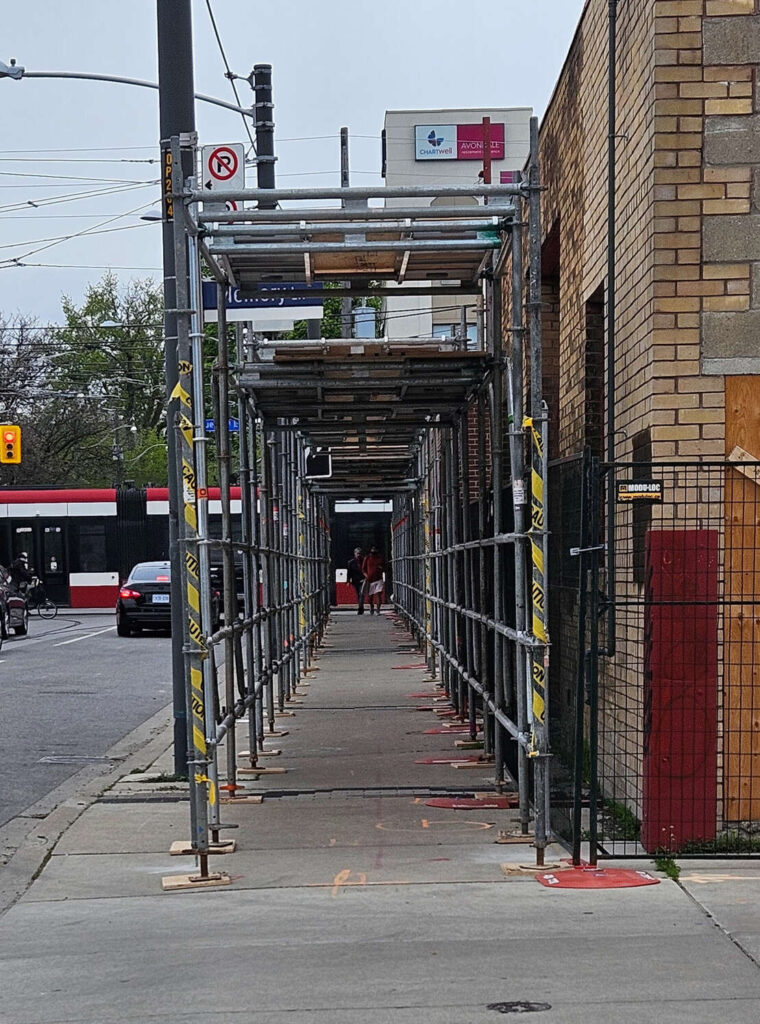
While complying with Toronto’s regulations is crucial, it’s equally important to go the extra mile in prioritizing safety. Implementing best practices for sidewalk scaffolding can help prevent accidents, minimize disruptions, and ensure a positive experience for everyone involved.
Pedestrian Safety: Keeping the Public Safe
- Clear Signage and Barriers: Erect clear signage and barriers around the scaffolding to alert pedestrians of its presence and guide them safely around it. Use bright, contrasting colours and easy-to-understand symbols.
- Adequate Lighting: Ensure the scaffolding and surrounding area are well-lit, especially at night or during low-visibility conditions. This helps pedestrians navigate safely and prevents accidents.
- Regular Inspections: Conduct frequent inspections of the scaffolding to identify any hazards like loose components, damaged planks, or tripping hazards. Address any issues promptly.
Worker Safety: Protecting Your Crew
- Fall Protection: Install guardrails, mid-rails, and toe boards on all open sides and ends of platforms. Workers should also wear appropriate personal protective equipment, including harnesses and lanyards, when working at height.
- Proper Training: Ensure all workers involved in the erection, use, or dismantling of the scaffolding are adequately trained and certified. They should understand safety protocols, hazard recognition, and emergency procedures.
- Safe Access: Provide secure and convenient access to and from the scaffolding, such as ladders or stair towers.
Environmental Considerations: Minimizing Impact
- Debris Containment: Prevent debris, dust, and other materials from falling onto the sidewalk or street. Use debris netting, tarps, or other containment systems to catch any falling objects.
- Noise and Dust Control: Take steps to minimize noise and dust pollution, especially in densely populated areas. Use noise barriers, dust suppression techniques, and schedule noisy work during appropriate hours.
Communication with Stakeholders: Building Relationships
- Nearby Businesses and Residents: Keep them informed about the project timeline and potential disruptions. Provide contact information in case they have questions or concerns.
- City Officials: Maintain open communication with city inspectors and address any compliance issues promptly.
By going beyond the minimum requirements and implementing these best practices, you’ll create a safer, more efficient, and more considerate construction environment. Remember, prioritizing safety not only protects lives but also enhances your project’s reputation and fosters a positive relationship with the community.
PEAK Scaffolding: Your Partner in Sidewalk Safety

In the busy cityscape of Toronto, ensuring the safety and accessibility of sidewalks during construction is paramount. At PEAK Scaffolding, we understand the unique challenges and regulations associated with sidewalk scaffolding in this vibrant city. We’re not just a scaffolding company; we’re your dedicated partner in navigating the complexities of sidewalk safety.
Expertise That Sets Us Apart
With years of experience serving Toronto’s commercial and industrial sectors, we’ve honed our skills in designing, installing, and maintaining sidewalk scaffolding that meets the highest standards of safety and compliance. Our team of certified experts is well-versed in Toronto’s specific regulations, ensuring your project adheres to all necessary guidelines.
We’re not just about meeting regulations; we’re about exceeding expectations. We take pride in our meticulous approach to every project, from the initial consultation to the final dismantling of the scaffolding. We understand that each project is unique, and we tailor our solutions to meet your specific needs, whether it’s a small renovation or a large-scale construction project.
Commitment to Safety, Compliance, and Customer Satisfaction
At PEAK Scaffolding, safety isn’t just a priority; it’s ingrained in our DNA. We follow strict safety protocols, conduct thorough inspections, and provide ongoing training to our team to ensure that every scaffolding system we build is secure and compliant.
We understand that navigating Toronto’s complex permitting process can be daunting. That’s why we offer comprehensive support, guiding you through every step of the application and approval process. We work closely with city officials to ensure that your project adheres to all regulations, minimizing delays and disruptions.
Our commitment to customer satisfaction is unwavering. We strive to build strong relationships with our clients, providing clear communication, transparent pricing, and exceptional service from start to finish.
Specialized Services for Sidewalk Scaffolding
Beyond our core scaffolding services, we offer specialized solutions for sidewalk scaffolding projects. These include:
- Custom Design and Engineering: We create tailored scaffolding plans that address the unique challenges of your project, ensuring optimal safety, accessibility, and efficiency.
- Expert Installation and Dismantling: Our experienced team handles the entire process, minimizing disruption to your project timeline and ensuring a safe and compliant worksite.
- Ongoing Maintenance and Inspections: We conduct regular inspections and maintenance to ensure your scaffolding remains in top condition and complies with all regulations.
- Emergency Response: We’re available 24/7 to address any urgent issues or concerns that may arise during your project.
Partner with PEAK Scaffolding for a Seamless Sidewalk Scaffolding Experience
When you choose PEAK Scaffolding for your sidewalk scaffolding needs, you’re choosing a partner dedicated to your project’s success. We bring expertise, reliability, and a commitment to safety to every project we undertake.
Contact us today to discuss your sidewalk scaffolding requirements and discover how we can help you achieve your construction goals while prioritizing the safety and accessibility of Toronto’s sidewalks.
Conclusion: Prioritizing Safety and Accessibility with PEAK Scaffolding
Sidewalk scaffolding is a vital element of construction projects in Toronto, ensuring the safety of pedestrians while allowing work to progress efficiently. Navigating the regulations, design considerations, and permitting process can be complex, but it’s a crucial investment in the success and safety of your project.
Remember, choosing the right scaffolding partner is equally important. At PEAK Scaffolding, we’re dedicated to providing safe, compliant, and efficient sidewalk scaffolding solutions tailored to your project’s unique needs. Our expertise, commitment to safety, and focus on customer satisfaction make us the ideal partner for your construction endeavours in Toronto.
Whether you’re tackling a small renovation or a large-scale development, trust PEAK Scaffolding to provide the support and expertise you need to keep your project moving forward while prioritizing the well-being of your workers and the community.
Ready to take the next step? Contact PEAK Scaffolding today for a free consultation and let us help you build a safer, more accessible Toronto.
Related Posts
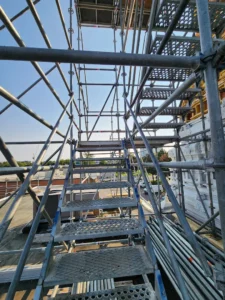

Toronto Building Codes and Scaffolding: What You Must Comply With

